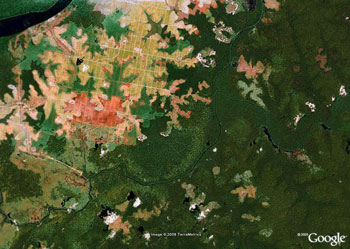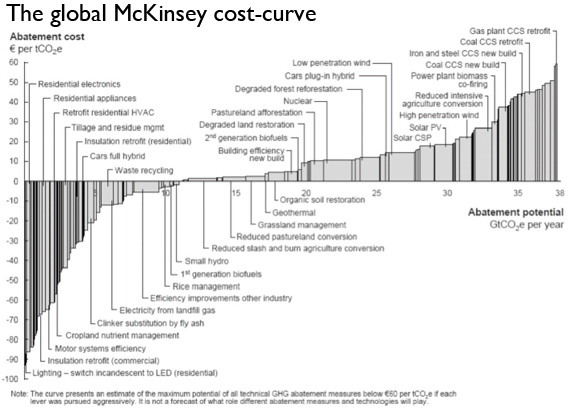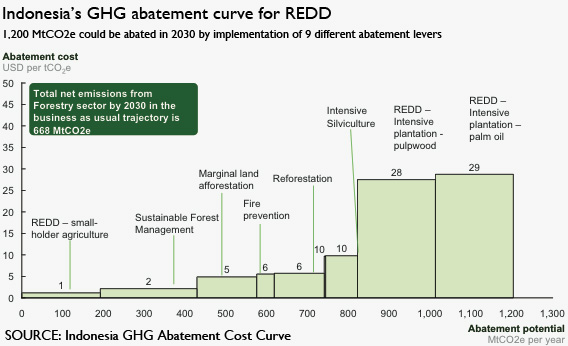|
|
A widely used representation of greenhouse gas emissions abatement costs doesn’t reflect the true costs of forest conservation, making the proposed reducing emissions from deforestation and degradation (REDD) mechanism seem cheaper than it actually is, argues a new report from the Rainforest Foundation UK.
Developed by McKinsey & Company, a consultancy, the carbon mitigation cost-curve shows the size of various opportunities for reducing greenhouse gas emissions for different activities in order of cost. Potential emissions savings (abatement) are on the x-axis and the cost (per metric ton of carbon dioxide) is listed on the y-axis. The model has been applied by several countries developing REDD strategies, including Indonesia, Guyana, Brazil, Democratic Republic of Congo, and Papua New Guinea.
 Courtesy of Google Earth |
But in a new briefing, McREDD: How McKinsey ‘cost-curves’ are distorting REDD [PDF], the London-based Rainforest Foundation UK says the cost-curve is underestimating the true cost of REDD, potentially “distorting” national REDD plans. The Rainforest Foundation UK argues that McKinsey cost-curve fails to account for transaction and implementation costs; neglects the challenges of governance; and “undervalues activities not integrated into formal markets, such as subsistence farming”.
“The approach is flawed as a policy-making tool as it does not consider alternative policy options, and favors policy that would allow industrial uses of the forest to continue business-as-usual, whilst penalizing subsistence activities,” states the briefing, which is authored by Nathaniel Dyer and Simon Counsell.
The authors note that forest communities are disadvantaged under the approach because it suggests their activities should be compensated at a much lower level than industrial interests—including loggers, plantation owners, ranchers, and large farmers—which generate higher output per unit of land. Dyer and Counsell argue that compensation postulated for smallholders under McKinsey cost-curve may be insufficient to actually reduce deforestation because it doesn’t account for the full opportunity cost of foregoing subsidence activities. Instead, by arguing for substantially higher levels of compensation for industrial forest developers, the curve seems to favor loggers and plantation developers continuing on a business-as-usual path.
 McKinsey & Company. (2009.) “Pathways to a Low-Carbon Economy: Version 2 of Global Greenhouse Gas Abatement Cost Curve.”, p. 7.  Indonesia’s National Climate Change Council (DNPI). (2010.) “Indonesia’s greenhouse gas abatement cost curve”. August 2010, p. 21. |
“McKinsey’s flawed analysis could be dangerous in the fight against climate change, as it makes it appear much cheaper and easier to tackle tropical deforestation than it would be in reality and it might lead us to postpone the real actions that need to be taken at home to prevent climate change. Priorities for reducing carbon emissions need to be based on the real costs of the different options, rather than on junk economic theory”, said Counsell, Executive Director of Rainforest Foundation UK, in a statement.
Counsell said the McKinsey cost-curve—in its current form—should be scrapped as a tool for designing national REDD plans. The Rainforest Foundation UK would instead like to see a more participatory process for evaluating the costs and opportunities of REDD.
For its part, McKinsey says it is “continuously researching the topic of abatement or mitigation” and accordingly, has updated its abatement curve twice since it launched in January 2007.
Related articles